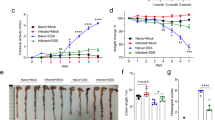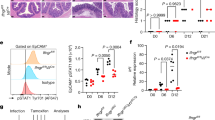Abstract
Colonic homeostasis entails epithelium-lymphocyte cooperation, yet many participants in this process are unknown. We show here that epithelial microRNAs mediate the mucosa–immune system crosstalk necessary for mounting protective T helper type 2 (TH2) responses. Abolishing the induction of microRNA by gut-specific deletion of Dicer1 (Dicer1Δgut), which encodes an enzyme involved in microRNA biogenesis, deprived goblet cells of RELMβ, a key TH2 antiparasitic cytokine; this predisposed the host to parasite infection. Infection of Dicer1Δgut mice with helminths favored a futile TH1 response with hallmarks of inflammatory bowel disease. Interleukin 13 (IL-13) induced the microRNA miR-375, which regulates the expression of TSLP, a TH2-facilitating epithelial cytokine; this indicated a TH2-amplification loop. We found that miR-375 was required for RELMβ expression in vivo; miR-375-deficient mice had significantly less intestinal RELMβ, which possibly explains the greater susceptibility of Dicer1Δgut mice to parasites. Our findings indicate that epithelial microRNAs are key regulators of gut homeostasis and mucosal immunity.
This is a preview of subscription content, access via your institution
Access options
Subscribe to this journal
Receive 12 print issues and online access
$209.00 per year
only $17.42 per issue
Buy this article
- Purchase on Springer Link
- Instant access to full article PDF
Prices may be subject to local taxes which are calculated during checkout







Similar content being viewed by others
References
Artis, D. et al. RELMβ/FIZZ2 is a goblet cell-specific immune-effector molecule in the gastrointestinal tract. Proc. Natl. Acad. Sci. USA 101, 13596–13600 (2004).
Lee, J. et al. Maintenance of colonic homeostasis by distinctive apical TLR9 signalling in intestinal epithelial cells. Nat. Cell Biol. 8, 1327–1336 (2006).
Nenci, A. et al. Epithelial NEMO links innate immunity to chronic intestinal inflammation. Nature 446, 557–561 (2007).
Zaph, C. et al. Epithelial-cell-intrinsic IKK-β expression regulates intestinal immune homeostasis. Nature 446, 552–556 (2007).
Taylor, B.C. et al. TSLP regulates intestinal immunity and inflammation in mouse models of helminth infection and colitis. J. Exp. Med. 206, 655–667 (2009).
Schickel, R., Boyerinas, B., Park, S.M. & Peter, M.E. MicroRNAs: key players in the immune system, differentiation, tumorigenesis and cell death. Oncogene 27, 5959–5974 (2008).
Bartel, D.P. MicroRNAs: genomics, biogenesis, mechanism, and function. Cell 116, 281–297 (2004).
Bushati, N. & Cohen, S.M. microRNA functions. Annu. Rev. Cell Dev. Biol. 23, 175–205 (2007).
Landgraf, P. et al. A mammalian microRNA expression atlas based on small RNA library sequencing. Cell 129, 1401–1414 (2007).
Koralov, S.B. et al. Dicer ablation affects antibody diversity and cell survival in the B lymphocyte lineage. Cell 132, 860–874 (2008).
O'Rourke, J.R. et al. Essential role for Dicer during skeletal muscle development. Dev. Biol. 311, 359–368 (2007).
Andl, T. et al. The miRNA-processing enzyme dicer is essential for the morphogenesis and maintenance of hair follicles. Curr. Biol. 16, 1041–1049 (2006).
Harfe, B.D., McManus, M.T., Mansfield, J.H., Hornstein, E. & Tabin, C.J. The RNaseIII enzyme Dicer is required for morphogenesis but not patterning of the vertebrate limb. Proc. Natl. Acad. Sci. USA 102, 10898–10903 (2005).
Barker, N. et al. Identification of stem cells in small intestine and colon by marker gene Lgr5. Nature 449, 1003–1007 (2007).
van der Flier, L.G. & Clevers, H. Stem cells, self-renewal, and differentiation in the intestinal epithelium. Annu. Rev. Physiol. 71, 241–260 (2009).
Velcich, A. et al. Patterns of expression of lineage-specific markers during the in vitro-induced differentiation of HT29 colon carcinoma cells. Cell Growth Differ. 6, 749–757 (1995).
Augeron, C. & Laboisse, C.L. Emergence of permanently differentiated cell clones in a human colonic cancer cell line in culture after treatment with sodium butyrate. Cancer Res. 44, 3961–3969 (1984).
Lee, Y. et al. The nuclear RNase III Drosha initiates microRNA processing. Nature 425, 415–419 (2003).
Cummins, J.M. et al. The colorectal microRNAome. Proc. Natl. Acad. Sci. USA 103, 3687–3692 (2006).
Kida, Y. & Han, Y.P. MicroRNA expression in colon adenocarcinoma. J. Am. Med. Assoc. 299, 2628 (2008).
Wu, F. et al. MicroRNAs are differentially expressed in ulcerative colitis and alter expression of macrophage inflammatory peptide-2α. Gastroenterology 135, 1624–1635 e1624 (2008).
Avnit-Sagi, T., Kantorovich, L., Kredo-Russo, S., Hornstein, E. & Walker, M.D. The promoter of the pri-miR-375 gene directs expression selectively to the endocrine pancreas. PLoS ONE 4, e5033 (2009).
Poy, M.N. et al. miR-375 maintains normal pancreatic alpha- and beta-cell mass. Proc. Natl. Acad. Sci. USA 106, 5813–5818 (2009).
Shroyer, N.F., Wallis, D., Venken, K.J., Bellen, H.J. & Zoghbi, H.Y. Gfi1 functions downstream of Math1 to control intestinal secretory cell subtype allocation and differentiation. Genes Dev. 19, 2412–2417 (2005).
Friedman, R.C., Farh, K.K., Burge, C.B. & Bartel, D.P. Most mammalian mRNAs are conserved targets of microRNAs. Genome Res. 19, 92–105 (2009).
McConnell, B.B., Ghaleb, A.M., Nandan, M.O. & Yang, V.W. The diverse functions of Kruppel-like factors 4 and 5 in epithelial biology and pathobiology. Bioessays 29, 549–557 (2007).
Dang, D.T., Zhao, W., Mahatan, C.S., Geiman, D.E. & Yang, V.W. Opposing effects of Kruppel-like factor 4 (gut-enriched Kruppel-like factor) and Kruppel-like factor 5 (intestinal-enriched Kruppel-like factor) on the promoter of the Kruppel-like factor 4 gene. Nucleic Acids Res. 30, 2736–2741 (2002).
Van der Sluis, M. et al. Muc2-deficient mice spontaneously develop colitis, indicating that MUC2 is critical for colonic protection. Gastroenterology 131, 117–129 (2006).
Saenz, S.A., Taylor, B.C. & Artis, D. Welcome to the neighborhood: epithelial cell-derived cytokines license innate and adaptive immune responses at mucosal sites. Immunol. Rev. 226, 172–190 (2008).
Kelly, D., Conway, S. & Aminov, R. Commensal gut bacteria: mechanisms of immune modulation. Trends Immunol. 26, 326–333 (2005).
Panesar, T.S. The early phase of tissue invasion by Trichuris muris (nematoda: Trichuroidea). Z. Parasitenkd. 66, 163–166 (1981).
Cliffe, L.J. & Grencis, R.K. The Trichuris muris system: a paradigm of resistance and susceptibility to intestinal nematode infection. Adv. Parasitol. 57, 255–307 (2004).
Wang, M.L. et al. Immune-mediated signaling in intestinal goblet cells via PI3-kinase- and AKT-dependent pathways. Am. J. Physiol. Gastrointest. Liver Physiol. 295, G1122–G1130 (2008).
Langlois, M.J. et al. Epithelial phosphatase and tensin homolog regulates intestinal architecture and secretory cell commitment and acts as a modifier gene in neoplasia. FASEB J. 23, 1835–1844 (2009).
Poy, M.N. et al. A pancreatic islet-specific microRNA regulates insulin secretion. Nature 432, 226–230 (2004).
McKenna, L.B. et al. MicroRNAs control intestinal epithelial differentiation, architecture, and barrier function. Gastroenterology 139, 1654–1664 (2010).
Hauber, H.P., Lavigne, F., Hung, H.L., Levitt, R.C. & Hamid, Q. Effect of Th2 type cytokines on hCLCA1 and mucus expression in cystic fibrosis airways. J. Cyst. Fibros. 9, 277–279 (2010).
Katz, J.P. et al. The zinc-finger transcription factor Klf4 is required for terminal differentiation of goblet cells in the colon. Development 129, 2619–2628 (2002).
Grimson, A. et al. MicroRNA targeting specificity in mammals: determinants beyond seed pairing. Mol. Cell 27, 91–105 (2007).
Kertesz, M., Iovino, N., Unnerstall, U., Gaul, U. & Segal, E. The role of site accessibility in microRNA target recognition. Nat. Genet. 39, 1278–1284 (2007).
Ishikawa, N., Wakelin, D. & Mahida, Y.R. Role of T helper 2 cells in intestinal goblet cell hyperplasia in mice infected with Trichinella spiralis. Gastroenterology 113, 542–549 (1997).
Friend, S.L. et al. A thymic stromal cell line supports in vitro development of surface IgM+ B cells and produces a novel growth factor affecting B and T lineage cells. Exp. Hematol. 22, 321–328 (1994).
Perrigoue, J.G. et al. MHC class II–dependent basophil–CD4+ T cell interactions promote TH2 cytokine–dependent immunity. Nat. Immunol. 10, 697–705 (2009).
Sokol, C.L. et al. Basophils function as antigen-presenting cells for an allergen-induced T helper type 2 response. Nat. Immunol. 10, 713–720 (2009).
Wynn, T.A. Basophils trump dendritic cells as APCs for TH2 responses. Nat. Immunol. 10, 679–681 (2009).
Rimoldi, M. et al. Intestinal immune homeostasis is regulated by the crosstalk between epithelial cells and dendritic cells. Nat. Immunol. 6, 507–514 (2005).
Tili, E. et al. Modulation of miR-155 and miR-125b levels following lipopolysaccharide/TNF-α stimulation and their possible roles in regulating the response to endotoxin shock. J. Immunol. 179, 5082–5089 (2007).
Bancroft, A.J., Artis, D., Donaldson, D.D., Sypek, J.P. & Grencis, R.K. Gastrointestinal nematode expulsion in IL-4 knockout mice is IL-13 dependent. Eur. J. Immunol. 30, 2083–2091 (2000).
Shi, R. & Chiang, V.L. Facile means for quantifying microRNA expression by real-time PCR. Biotechniques 39, 519–525 (2005).
Stern-Ginossar, N. et al. Host immune system gene targeting by a viral miRNA. Science 317, 376–381 (2007).
Acknowledgements
We thank S. Robine (Institut Curie, Centre National de la Recherche Scientifique) for Villin Cre-ERT2 mice; C.J. Tabin (Harvard Medical School) for Dicer1fl/fl mice; P.P. Pandolfi (Harvard Medical School) for Ptenfl/fl mice; K. Rajewsky (Harvard Medical School) for antibody to Dicer; I. Ben-Porath (Hebrew University) for reagents; H. Clevers for IEC-isolation protocols; Y. Smith for assistance in genomic data analysis; M. Leshets and I. Burstain for handling the confocal microscopy; and R. Goldstein for critical review of the manuscript. Supported by the Israel Science Foundation, Israel Cancer Research Fund, Hadassah Medical Center (A.L.), the German-Israeli Foundation, the Dr. Miriam and Sheldon G. Adelson Medical Research Foundation and the Crohn's & Colitis Foundation of America.
Author information
Authors and Affiliations
Contributions
M.B. and A.L. did experiments, analyzed data, provided ideas and contributed to the writing of the manuscript; M.S. did experiments, analyzed data and contributed ideas; I.A., H.M., F.Z. and E.H. did experiments and analyzed data; G.C. provided bioinformatics assistance; S.K.-R., T.A.-S., M.N.P., D.A., M.D.W. and E.H. provided ideas and experimental reagents; Z.B. and E.H. contributed to preparing the manuscript; and Y.B.-N. and E.P. directed the study, contributed to the writing of the manuscript and supervised the work.
Corresponding authors
Ethics declarations
Competing interests
The authors declare no competing financial interests.
Supplementary information
Supplementary Text and Figures
Supplementary Figures 1–9, Supplementary Tables 1–4 and Supplementary Methods (PDF 1243 kb)
Rights and permissions
About this article
Cite this article
Biton, M., Levin, A., Slyper, M. et al. Epithelial microRNAs regulate gut mucosal immunity via epithelium–T cell crosstalk. Nat Immunol 12, 239–246 (2011). https://doi.org/10.1038/ni.1994
Received:
Accepted:
Published:
Issue Date:
DOI: https://doi.org/10.1038/ni.1994
This article is cited by
-
Bojungikgi-tang improves skin barrier function and immune response in atopic dermatitis mice fed a low aryl hydrocarbon receptor ligand diet
Chinese Medicine (2023)
-
Dysregulated microRNA expression in IL-4 transgenic mice, an animal model of atopic dermatitis
Archives of Dermatological Research (2021)
-
Intestinal anti-inflammatory effects of probiotics in DNBS-colitis via modulation of gut microbiota and microRNAs
European Journal of Nutrition (2021)
-
Apoptotic tumor cell-derived microRNA-375 uses CD36 to alter the tumor-associated macrophage phenotype
Nature Communications (2019)
-
Vibrio cholerae derived outer membrane vesicles modulate the inflammatory response of human intestinal epithelial cells by inducing microRNA-146a
Scientific Reports (2019)



